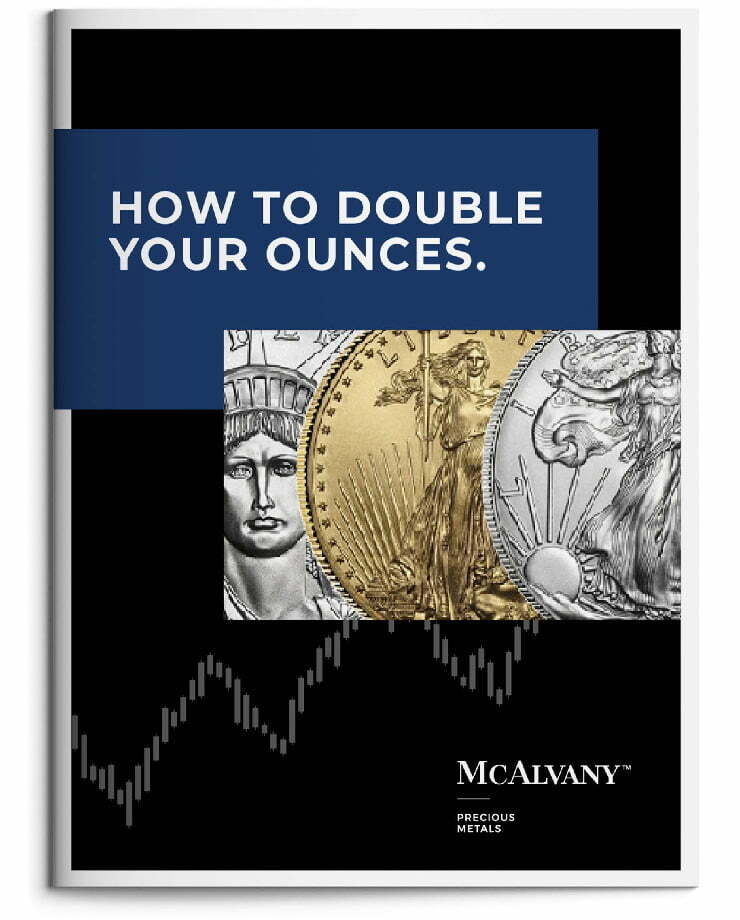Podcast: Play in new window
- AI Tech Bubble Says, “Feed Me”!
- How Will Trump Respond To Financial Instability?
- The Fed Can’t Get Longer Maturity Interest Rates To Go Down
“This is one of the factors which is super bullish for gold. Bond markets are signaling a divergence for monetary policy, and implicitly saying that either fiscal commitments are already too great or inflation is coming back. Perhaps it’s a combination of the two, but either way, yields are telling you where rates are headed next, and it’s not lower. The implication is that financial market stability is very much in the cross hairs.” —David McAlvany
Kevin: Welcome to the McAlvany Weekly Commentary. I’m Kevin Orrick, along with David McAlvany.
David, I was just going back and looking at discussions we’ve had in the past on catastrophe math. Zeeman made that very famous back in the 1960s, 1970s, and what it basically boils down to is, certain factors build to a tension point, like a bridge. A bridge may work for 40 or 45 years and then suddenly collapse. And the question is, is there any math behind that? Is there any predictability in the timing behind that? And you’ve just brought up in our meeting the sand pile effect, same type of thing. Let’s talk about that a little bit because there are some tensions building right now in one direction that can’t hold forever.
David: Well, first of all, welcome back. You had more eventful weekend than I did, and I’m glad you’re in—
Kevin: Speaking of catastrophe. Yeah.
David: Yeah. You’re in good repair, stitches and all.
Kevin: Yeah. Yeah, emergency appendectomy, but boy, am I happy that we have a medical system that can actually get that kind of thing out.
David: Well, looking ahead to two weeks out, we can put it on the calendar. January 30th, Doug and I will tackle perhaps the toughest analytical mashup ever on our quarterly Tactical Short call. Starting 2025, there is a confluence of major concerns—and this is to your point, Kevin. When you start looking at the various factors, you don’t know, considering that sand pile effect, which grain is the culprit for the slide, but there’s a confluence of major concerns, whether it’s fiscal, economic, financial market—encompassing both equities and bonds, geopolitical and strategic considerations that make this Tactical Short call a feast for the inquisitive.
And, I think, full of opportunity, if you are observant and in the markets and agile, assuming you can get a few of these macro themes right. I think the difference could be between your best performance in a calendar year or your worst, and 2025 is shaping up to be very, very interesting. Of great consequence long-term are the impacts on society as a larger expression of your own balance sheet expansion or balance sheet compression because there is a mirror, there is an echo, a reflection.
Kevin: Yeah. We just heard Morgan give the update to our meeting today, and he said we have two major, major issues right now, inflation and a debt problem, the interest that we have to pay on our debt. And he calls that a debt spiral. It gets to the point where the Federal Reserve has lost control and we talk about catastrophe. You can have inflation and manage inflation if you don’t have too much of a debt problem. You can have a debt problem if you don’t have inflation, but when the two come together, it creates a major issue. And I know you’ve got some other major issues. I would imagine one of the issues you guys are going to talk about is the bond market, which reflects that.
David: Well, again, one of the key issues there is with debt being at the level it’s at, typically the way that you would fight inflation is by raising rates, except if you’re raising rates because of how much debt we already have in play, the interest component is already at an overwhelming level. So to raise interest rates just piles on even more to the deficit via the interest component. And that is unique because typically a debt crisis can be solved by inflation. But that’s if and only if the scale of the debt hasn’t gotten to the point where your budget line item is the single largest line item, as it will be this year. Interest will be the largest budget line item for the US, which is just an absurdity. That’s why the inflation problem and the debt problem are unique in this particular period of time.
But major issues in 2025, which we’ll give a preview to in the Tactical Short call. And then of course, we’ll do the full year 2024 review as well. I think we could sum it up this way. The bond market, it’s vital and it’s already on the move. I think at this point, you could ignore the Wall Street narratives, and if you don’t, your losses will be catastrophic.
Another factor is China. It’s vital in dealing with acute economic fragility. Even as we speak, with some of their biggest property developers, the ones that have been state supported now also circling the drain. So, the indications are that their best efforts to resolve pressures within the economy are falling to pieces. We’ve got China, the largest contributor to global GDP. It’s quickly moving towards a deflationary Japan 2.0.
Kevin: Will that affect Chinese currency?
David: And I think that’s the third factor, where I think it’s vital. The RMB is on the edge, and the PBOC has had to come out multiple times in the last 30 days to defend the currency, to ward off speculators and warn them that they will be in the crosshairs, most literally. $3.2 trillion in currency reserves gives the PBOC the capacity to defend the currency, and again, that’s as long as they can create those disincentives for currency speculators. So watch the offshore RMB. It trades as sort of two almost separate entities. The onshore RMB is what can be directly controlled. The onshore trades within a 2% band and the government will spend, the PBOC will spend to maintain the band, but the offshore is not controlled. And so that’s where I think you can watch to see a breaking of that 7.3 level, which we already have, but deteriorating even worse. You can look for it in the offshore RMB with the onshore to follow.
Kevin: So Dave, sometimes, you’ll hear risk-on dynamics, risk-off dynamics. Would you explain that a little bit because the markets operate that way. They’re either charging in or they’re charging out, and which one’s risk-off, risk-on and how does that play out going forward?
David: Yeah, I mean it’s really the difference between risk taking and risk mitigating. If I were a skier, it would be leaning into the curve and taking it as fast as I can regardless of other factors—or, if I’m trying to dump speed and gain control. One, I’m increasing my risk; the other, I’m trying to mitigate my risk; and that’s kind of the contrast. The movement of risk-off dynamics is something that we look at from the periphery of the markets—small players, small countries—and then moving more towards the core. I think this is also a vital aspect in 2025.
We’ve already seen this in emerging market bonds and currencies—what we would describe as the peripheral economies, as well as in peripheral European countries where yields are on the increase, currencies are under pressure. At the edge, things are already a bit disheveled. You’ve got rising yields. That introduces pressure that ultimately corporations have to manage. And so far they’ve done a very good job of managing it. But again, it’s the marginal country balance sheet. It’s the marginal corporate balance sheet which has the most volatility dead ahead.
Kevin: The carry trade has been such a critical thing, really for a long time, Dave. The Japanese carry trade we talk about, it’s highly leveraged. What does that look like going forward?
David: Well, again, just like the Chinese are defending their currency with verbal tactics first and then with hard dollars or hard yuan, the Bank of Japan is doing the same thing. They are doing what they can to defend the yen verbally, and they’ll spend yen if they have to. So the carry trade is sitting precariously, as is the basis trade, and they’re vulnerable—both—to a change in market conditions.
Kevin: So Dave, on these carry trades, it’s the leverage that actually creates the problem. What kind of leverage do we have? Five to one, 10 to one?
David: Well, and particularly with the basis trade, where you’re dealing with the repo markets and futures markets for Treasurys, you’re talking not five to one, not 10 to one, more in line with 50 to as much as 200 to one leverage.
Kevin: Well, that’s incredible.
David: Yeah, that would be a half a penny on every dollar, so the leverage is astounding. I think it’s telling when the Bank of International Settlements—or the central bank to central bankers—lists it as a concern coming into 2025. It’s worth thinking about. Major trading firms continue to press this bet, caution is certainly warranted, but it’s not being managed well, I think. There’s no one entity large enough, with enough scale, for the bailouts required. I mean, again, a trillion dollars is known to be tied up in the basis trade, but you can then use your multiplier for the real scale of the bet, and it literally is picking up pennies in front of a steamroller.
Kevin: One of the things that’s been a major factor over the last two years—well, especially last year—was the AI tech bubble. And there’s no one denying that artificial intelligence is going to play a key role going forward, but is it paying the bills?
David: It is a revolution. We’ve talked about that in past Commentaries, where, yes, it represents change, but this is, as it takes on bubble dynamics, it’s vital for 2025. This was and is still the justification for nosebleed valuations and unchecked market enthusiasm throughout 2024. What you’ve ended up with is concentrated exposures which are very vulnerable to a shift in liquidity. Last week, we spent some time talking about breadth, and the bubble that we have in AI and in tech requires a continued flow of basically limitless capital with no expectation of near-term return on capital.
And I think this is one of the critical shifts in Q4, as we’ve listened to a number of quarterly calls. You’ve got executives saying, “Yes, we’re going to continue to invest in AI.” The questions have been presented to them: At what point do you see this as acretive? When will we profit from this? Where does the investment pay off? And they’ve stumbled and stammered over a time frame, basically saying, “Well, it’s not quite there yet. We really don’t know.” And again, how much time do we actually have before the market re-examines its return expectations? The money is being invested towards what end? How long will the liquidity continue to flow? That puts the AI bubble very much at the top of the list for 2025 as a potential problem.
Kevin: This may be a poor example, but I think of Henry Ford making Model Ts. He was paying the bills from the beginning, but what if he knew that someday the Mustang, the Ford Mustang was going to be the thing in the 1960s? Well, if he had the build for decades to actually get to the point of making a Mustang without really selling a lot of Model Ts on the way, that would almost be an impossibility. And there are technologies out there that we know in the forward windshield are going to be fabulous or least productive, but if it’s not right now, where does the money come from?
David: Well, this works as long as financial conditions remain incredibly loose and there is no call. There is no end of the timeframe as long as liquidity is ample. It’s when liquidity dynamics shift that people begin to reassess all the bets that have been made, and the requirement for them to pay is now, in the immediate. The other issue which we’re up against, and again, these are sort of the major issues in 2025, we’ve got fiscal spending which we already know is bloated. Budgets, the CBO projects a $2 trillion budget deficit for 2025, 1.9. Now we have climate-inspired fiscal spending which will further bloat budgets and add to inflationary pressures.
So this was not included in the CBO’s estimates. When we look at Helene, when we look at Martin, when we look at what happened on the East Coast, now what’s happening on the West Coast with the fires, not even to mention the possibility of recession and the Keynesian tap yet to be opened to prop up aggregate demand, there, in our estimate, sometime in Trump’s next four years you’ll have that $2 trillion estimate multiplied to 4 or 6 trillion in a single year. Debt markets are very sensitive to sustainable cash flows, and they are very close to judging the current setup as pure Ponzi finance.
Kevin: We do have a new administration coming in, probably a tougher—well, definitely a tougher—administration than what’s going out as far as the geopolitical situation, but there are still a lot of unknown geopolitical risks that are out there, China, Taiwan, Turkey, Russia. That probably is something that we have to factor in as well. I mean, even though Trump is seen as a great negotiator, sometimes negotiations break down.
David: Well, and so 2025, certainly geopolitical risks are front and center. Yes, China and Taiwan are right there at the forefront. You could also look at Iran, Israel, Turkey, and potential engagement between Israel and Turkey, as Turkey sort of reasserts itself and tries to flex its muscle, a resurgence of the Ottoman Empire, so to say. Russia, Ukraine—obviously, that’s still vital. But I think it’s important to remember that desperate administrations do the irrational. They do desperate things, and we’ve got a number of countries, whether it’s the Chinese economy and the need for diversion, the rallying point towards sort of domestic nationalism, if you will, or the ongoing conflicts in the Middle East, we’re now at a critical juncture. Iran may be the 2025 flashpoint as they move even closer to their aspirations to be a nuclear power, something that will not be tolerated by Israel. Osirak 2.0, that’s a real possibility in 2025.
Kevin: Moving over to the financial markets, you talked about breadth last week, and I just want to restate that 70% of market activity has been in seven stocks—the Mag-7. And there’s an old saying in the markets that you buy the rumor, you sell the news. With Trump coming in, do we possibly have a market top coming?
David: Well, this is one of the reasons we highlighted the similarities between Reagan taking office and the market gyrations. Very positive on the front end, but then dealing with the realities of a recession, overvaluation in the stock market, and of course what was happening in the bond market, too, as interest rates moved upwards of 20% as Volcker was trying to crush inflation. He had the latitude to do that. Yes, we were indebted. Yes, there were fiscal concerns. But he actually had the latitude to increase rates to 20% without bankrupting the country. Certainly put a lot of pressure on corporates and put us into a recession, but ultimately, did resolve the inflation issue. Financial fragility is one of those things that is front and center for 2025, and it’s absolutely vital. I think the market tops are in, and like the fourth quarter of 2021, it’s now a matter of time for market players to reposition.
Kevin: Do you think there’ll be a Trump administration reaction to financial instability?
David: That, I think, is a tricky question. How will they respond, and how much will Trump pound the table in terms of what should the Fed do to intervene? And I think this is vital. How do you deal with financial instability? Monetary policy is more constrained now than at any other time this century, and how financial instability is addressed is the $10 trillion question. Inflationary consequences are not hard to imagine.
Kevin: So Dave, you’re going to talk about all this with Doug when? And how do our listeners listen to it?
David: Yeah, so you can register for the call. It is on January the 30th. The Tactical Short call will be then, and you can follow the show notes to that registration page. I mean, any one of these issues is consequential. All together or in some combination, our collective resources are likely to be stretched. So in the last Credit Bubble Bulletin, Doug asked the question about the insurability of some states. We’re talking about California with the fires, Florida with the winds and floods. And he observes that climate disasters, these days, come in waves. And it’s not the pattern which insurance actuarials prefer, covering accidents in sort of a random and dispersed manner. No longer are they random and independent. Doug draws the parallel to market losses, which of late have come in waves as well. In a sphere where both positive and frankly negative performance correlations are on the rise due to a combination of easy money policies, loose financial conditions, you’ve got waves of losses which threaten stability in a remarkable way.
Kevin: Dave, this wave thing is really interesting because this goes back to catastrophe. I was talking about a bridge, but I remember when I was 18 years old and I was in a music group that was asked to go out to the Hyatt Regency in Kansas City to perform. And we were moving speakers across— There was a bridge inside the Hyatt Regency, and on Friday nights they had a ballroom dance for people who came in, and I remember the dance was going on and people were up on the bridge. They were down below. The bridge, I think, was on the second or third floor.
And yeah, we just continually moved equipment across, and I found out the next week, I heard the news that that bridge collapsed, and it was on a Friday night. It was when they were having that ballroom dance, the Hyatt Regency in Kansas City. It was a terrible tragedy, but it was explained that there were harmonic waves that started to parallel with each other. It’s really amazing. I hadn’t really remembered that until you just talked about this, but Doug is saying the same thing. We don’t have a random spread across the curve. What we have is the curves all waving together, and I would imagine that, in the markets anyway, that causes a lot of mispricing.
David: Well, and I think some of the mispricing, some of the exaggeration and misallocation of capital has come from what people believe to be reliable hedging strategies. These strategies give the perception that your risk is covered, and rather than stop there, it encourages further risk taking—not just a mitigation of one set of risks, but actually an increase of total systemic risk because you assume that what you’ve already put at risk is adequately hedged. So market operators assume that they are insured via derivative exposures, which are thought to act as a form of protection. But the wave nature of market declines, inclusive of many asset classes at once, leaves the complex system of derivatives insurance looking more like a daisy chain of interconnected risks with limited places to hide.
Kevin: Well, let me ask on the California fires. I mean, we feel for every one of those people who are affected, and our prayers are with you, but from what I understand, only about a 10th of what we’re seeing destroyed right now is actually insured. Is that what you’ve seen?
David: Last week, the estimates were 50 to 75 billion dollars in total losses, with about 10% of that being covered by insurance. Now, losses are estimated in the 250 to 275 billion dollar range, again, with only a fraction of that covered by insurance, somewhere between 20 and 30 billion. Within the financial markets, there are, if you want to think of it in Warren Buffett’s terms, a lot of naked swimmers. And they’re exposed as such when the tide goes out. Huge losses. Partial, if any, real coverage. Or maybe even like what we discovered in 1987 with what was called portfolio insurance at the time, these were automated hedging programs designed to protect portfolio downside. How they actually operated ended up contributing to and exaggerating declines. That’s what happened in October of ’87.
Kevin: So you highlighted a number of issues. How does that apply to gold?
David: Well, we will explore some of these issues in further detail on the 30th. Again, join us, register today. Don’t forget to mark your calendar for the Tactical Short call. We often conclude with a short reflection on the gold price, and I’d like to focus on the topic in our remaining time today. There’s key price drivers that exist today which have been more or less, if you want to look in the past, theoretical catalysts, but are overwhelmingly real in real time now, today. So the short list of concerns for 2025, that covers sort of an A list of realities that the market is now being forced to come to terms with. And again, this is right now.
Kevin: This goes back to what we were talking about with Morgan. Morgan brought up this morning that the Fed is really, really in a corner. If they raise short-term rates, long-term rates go up. If they lower short-term rates, which is what they’ve been trying to do, long-term rates go up. So no matter what we’re talking about, the bond market is basically signaling right now that the Fed’s not in control.
David: And I think this is one of the factors which is super bullish for gold. Bond markets are signaling divergence from monetary policy, and implicitly saying that either fiscal commitments are already too great or inflation is coming back. Perhaps it’s a combination of the two. But either way, yields are telling you where rates are headed next, and it’s not lower. The implication is that financial market stability is very much in the cross hairs.
Kevin: Yeah, so gold as a true insurance policy, I mean, that’s the real insurance policy, isn’t it?
David: Yeah. Gold as true insurance takes the stage in 2025, following a 2024 gain of over 25%. Gold has now surpassed stocks, has surpassed bonds, has surpassed the US dollar with superior performance thus far this century. The S&P, according to Bloomberg, is now up, on a compound annual growth rate, 7.689%. The US aggregate bond index, again on an annualized basis, 3.93%, since the beginning of the century. The US dollar up a quarter of a percent, and gold’s compound annual growth rate from the end of December 1999 to the end of December 2024, 9.23%.
Kevin: That’s every year we’re talking about. Yeah, 9.23% on average, just going back 25 years.
David: That’s the positive years, that’s the negative years. You put them all together and that’s your compound annual growth rate, almost 9.25%. Now you would think with last year’s 25% gain in gold that it was one of the more popular trades, and that’s not the case. Last year, we had US gold ETF holdings, as we tally the full year, declined by 3.2%. So the actual holdings of gold via the exchange traded funds was down for the year. The share count for GDX, which is one of the proxies for, or a basket of, gold stocks—gold miner ETF—the share count shrank by over 10%.
Kevin: Wow.
David: In other words, it’s a neglected space in terms of US investor allocations. The 2024 price catalysts were geopolitical and primarily central bank driven. They were not investor driven. So you’ve got an asset class that has strong outperformance characteristics, and it’s been largely neglected by Western investors. Instead, they’ve chosen to narrowly focus on the Mag-7. So I think the catalysts in 2025 and beyond tie back to our 2025 list of real-time dynamics, start with a bond market which exhibits bear market behavior, which is just rising yields. And of course, the inverse of that is falling prices for those bonds. This, to date, has been concentrated in government issued IOUs, and is likely to migrate to corporate credit, particularly high yield. Of course, I think leverage loans and your marginal bets, the fringe borrowers, those debt obligations are going to come under pressure in 2025.
Kevin: So your person with the permanent portfolio, when you go to your broker and he says, “Okay, now if you’re really aggressive, we’ll go in with stocks. If you’re really conservative, we’re going to go to bonds.” That permanent portfolio, that just doesn’t work in this case.
David: Well, I would say that the classic balanced portfolio is really what’s in question. You’ve got the hedge fund traders who like to take a lot of equity risk and will hedge that with fixed income. Those are your risk parity traders. You’ve got the 60/40 portfolio owner. Those kinds of positions are awkward, awkward as you come into 2025. Offsetting equity risk with a bond portfolio is likely to feel something like 2022. For those that don’t recall 2022, bonds were not a risk diversifier in a rising rate environment. And that’s exactly what we continue to see in the bond market today.
The assumption of low correlation between these asset classes, it’s already been tested in recent years, and I think we’ll test it again. So we begin 2025 with a steepening yield curve. We begin 2025 with credit spreads the tightest in recent memory. I think the difference between 2022 and 2025 will be that it’s not so much a duration issue. That was the case in 2022. I think credit quality is likely to be very much center stage in 2025. Credit spreads recently hit their lows going back to 2007. Of course, that was just before the global financial crisis.
Kevin: Yeah, and so this reminds me again of what Morgan talked about last week. When he was talking in our meeting, he said, “PIMCO.” And anyone who watches the bond market or even whether they’re invested in bonds or not knows the name PIMCO. And PIMCO has already commented that they’re very concerned about US deficits, which made it sound like PIMCO wants to back away.
David: Yeah. I mean, if you treated PIMCO as an institutional bellwether, it tells you a lot about the shifting view of US debt, and particularly, Treasurys. The quote from PIMCO in December was, “At PIMCO, we are already making incremental adjustments in response to rising US deficits. Specifically, we’re less inclined to lend to the US government at the long end of the curve, favoring opportunities elsewhere.”
We often talk about the migration of risk from the periphery to the core, and perhaps in the bond market, it’s the reverse of our periphery-to-core thesis. The core, which would be your government bonds, have problems, and a move to the periphery is all but certain. So at the core, financing our obligations is a concern. So maybe we just cut spending. Perhaps that is the solution in 2025.
Kevin: And actually, there’s a lot of hyperbole right now. I think there’s a lot more talk about cutting spending than what they’re actually able to do. There’s not a lot to work with that isn’t already—like Social Security and interest payments and the military. There are things we just plain can’t cut. So are Elon and Vivek, are they going to be able to pull a rabbit out of the hat?
David: Yeah, I think you’re talking about rhetoric and promises that are made during an election cycle. So November is behind us. So now we deal with the reality of governing and budgeting, and so, no, I don’t think Elon or Vivek, the caped crusaders, they are certainly going to make their best efforts. But cut from what, I think is really the most reasonable question. You’ve got 80% of government spending which is off the table to start with because these are the entitlements, this is defense spending, which for 2025 has already increased by 9 billion, not decreased. You’ve got the interest component, which is going to surpass even the entitlements—Social Security, Medicare—it will be greater than those. That’s all nondiscretionary.
So the question really is, what percentage of the 750 billion dollars that remains is likely to be cut? If they’re lucky, 150, 200 billion in cuts. That reduces our budget deficit by a mere 10%, and that’s a best-case scenario. So again, there’s an issue at the core, and I fear that in this case it might be spreading to the periphery, where the corporate borrower is today issuing debt like mad, knowing that rates are moving higher. More important is, as I think the corporate exec saying, “Credit spreads cannot remain this tight. Better to refinance today than tomorrow.”
Kevin: Dave, if I’m anybody but the United States, let’s say I’m borrowing in dollars, rising rates, my currency is depreciating against the dollar. That makes it more and more difficult for me to pay my debts back to the United States in dollars.
David: And I think what’s happening in the emerging markets is a bit of a foreshadowing of what is likely to happen in the corporate landscape as well. Rising rates, depreciating currencies in the emerging markets, these are events that were clearly in a 2024 focus, but now we look at the US and the European financial markets. If the benchmarks for US debt, UK debt, European debt in general, are moving higher, then everything is ultimately moving higher. And the pressure that creates will show up in the form of widening credit spreads and a decrease in the value of corporate equities.
So just like we had the currency declines of 2024, the equivalent of a country’s equity—again, the currency—I look at this and I think, this is a bullish set-up for gold. Bond investors frustrated with the lack of safe haven characteristics in bonds have limited options for risk control, and gold is center stage in the context of an accelerating bond bear market.
Kevin: Yeah, and not only currencies, people can hedge. Right now, they’re not wanting to hedge as much in the dollar as it used to be. They can hedge in gold. But I came in 1987, Dave, when we had the major stock market crash that was somewhat unexpected by a lot of people. And I was here for the year 2000 when we had the tech stock bubble crash. Gold bottomed at that point and started rising. 2008, we know what happened with gold. It dipped and then it went way up. Gold is an attractive hedge, not only against currency risk, but financial or equity risk as well, isn’t it?
David: Yeah, for sure. I think just to underscore, it’s a bond bear market which puts gold front and center as a risk mitigator. And it is also an attractive asset in the context of an equity bear market. So last week we discussed over-valuation in equities, over-concentration in just few names. We’ve got the Buffett ratio, we’ve got the Q ratio, we’ve got price to sales, price to book, the cyclically adjusted price earnings ratio, the average household allocation to equities, the current S&P 500 dividend yield. These and many more, are already in the 98th to 100th percentile, putting them at or near historical high water marks.
So yes, if liquidity dynamics are maintained, this price structure can be maintained as well. If liquidity dynamics increase, we can move to even more extreme levels. But if liquidity dynamics shift, you have a bear market for the history books in the making within the equity markets. So gold is center stage in the context of an accelerating bear market in equities.
Kevin: Yeah, you talk about being in that 98th to 100th percentile. I just feel very blessed that I was at the Hyatt Regency the Friday before the bridge fell. It was terrible for the people who were there. But no one really knew the stresses that we’re building there until it ultimately failed. Now, let me ask something that is always controversial. We always get comments. No matter what we say about cryptocurrencies, somebody’s got an opinion about it. But what about cryptocurrencies?
David: Yeah, I mean, if we end up with headwinds in the cryptocurrency market, ethereum, bitcoin, ripple, and literally the thousands of others that are there, don’t forget the one that is named after the euthanized squirrel, which is now valued at over $1.8 billion.
Kevin: Right.
David: It’s only been around for about 60 days. These speculative instruments have moved in lockstep with equity prices, and, in my view, are very symptomatic of the risk-on environment that we had in 2024. We’ve got the market cap of crypto, which has overtaken the market cap of the Russell 2000 at right around $3.7 trillion. If you compare that, for instance, to the market cap of buyable gold, that’s at around $4 trillion. There’s obviously more gold that exists in the world, but not that is available. So last year, we saw the approval of the bitcoin ETFs that enticed investors into the space, and within less than a year, the demand exceeded—for those Bitcoin ETFs—exceeded all of the US gold ETFs. A fascinating stampede, a total stampede.
So obviously, that proves that crypto has unique supply and demand dynamics and supply constraints. That’s what shows, it’s sort of that radical spike in price. There’s an underappreciated supply constraint in that a part of what makes it so limited, is the concentrated ownership by just a few whales. The float of available crypto is minuscule, and the majority of it is controlled by the founders, controlled by early adopters. This is really critical because as we highlighted last week, markets exist to match buyers and sellers. There are thus these platforms, whether it’s a Charles Schwab or Fidelity, they perform that function with equities, and there are market makers in the world of bonds.
If we repeat a 2022 style market of cross asset declines, we’re not dealing with an asset class, specifically in cryptocurrencies, that has as robust a market making function, right? So what did we witness in 2022 when, yes, stocks were down, bonds were down, real estate was down, crypto was down. Bitcoin dropped 74% in 12 months, 74% in 12 months. So perhaps between 2022 and 2024, crypto has come of age and my concerns over liquidity in the space are just overblown. But a decline like 2022, nearly three quarters of the value disappearing, again, that would put gold center stage as a portfolio insurance play without equal.
Kevin: It just strikes me that everybody needs more dollars. You talked about how the stock market, AI and that industry, you’re going to have to have a continual flow of more dollars coming in. Crypto needs a continual flow of more dollars. Our government, obviously, needs a continual flow of more dollars. Let’s talk about the dollar, then. Is the dollar something that, as we see these things, is the dollar going to become more and more desired?
David: And you can certainly draw that conclusion from last year’s performance in the dollar. It was up 7%. There was an increase in demand for dollars. Part of that was, pressure at the periphery. We’re talking about European and emerging market economies, and currencies that were under extreme pressure. But I think this is the last aspect of gold demand, which comes from—let’s call it dollar driven dysfunction. As there is more demand for dollars and the dollar appreciates, the problem with that is that dollar strength increases pressure everywhere, and reinforces a version of global market dysfunction, until that feedback loop is disabled. 2024, the dollar increased by 7%. Emerging market currencies were down anywhere from 10 to 22%. And in a very telling divergence, the significant shift from expecting gold to decline in light of dollar performance to the upside, didn’t happen. We actually had gold strength. I think that’ll continue to be the case and it certainly has been the case here in early 2025.
Kevin: Dave, one of the great drivers of the world economy has become China. Aren’t they number one in GDP right now? Can they, speaking of needing more and more and more, can they continue to deliver more and more and more?
David: They’re way down the list. Well, not way down the list, but number two in terms of total GDP. But in terms of contributing to total GDP growth, they are number one. So when we think about US dollar-denominated debt, this is kind of a complicating factor. Kevin, if you go back to the 2008 and 2009 time frame, you find something quite similar, where there was a lot of cross border debt. And so for instance, in Iceland it was a lot cheaper to borrow in Swiss francs. The problem was, as the Icelandic currency started to devalue, the ability to pay back that debt in terms of Swiss francs—which were appreciating—became so great that actually, you ended up with a currency crisis.
So in the same way, US dollar-denominated debt can become a very complicating factor. Again, usually this is the case with a rapidly increasing currency when you’ve got cross border debt. Earlier, I was mentioning China entering what appears to be a Japanification or Japan style deflation, Japan 2.0. I think there’s a similar replay of historical events, with the US dollar being very strong. If that continues, if that continues, you’re talking about massive hemorrhaging in the emerging markets and the potential for currency crises globally. Should that continue, it’ll have to usher in—or it’s likely to usher in—1985 2.0, if you remember what happened in 1985. It’s a Plaza Accord.
Kevin: Yeah, the Plaza Accord. Yeah.
David: Yeah. That was the coordinated global agreement to devalue the US dollar. We’re not there yet. A stronger dollar in rising rates, yes, they have the effect of tightening global financial conditions, something that central banks are not enthusiastic about. Again, if you’re creating monetary policy for your country, then you have this sort of external and unwelcome agent making policy decisions for you. It’s beyond a nuisance.
Kevin: In most circumstances, Dave, if a person was saying, “Well, I want to make money on gold,” they would say they want to see the dollar fall. But what we saw last year is a change in dynamic, and you’ve pointed this out, and that is the dollar rose. Actually, it was a strong rise, and gold had an even stronger rise. So we could be in a completely new era. Whether they devalue the dollar with, let’s say it’s a 2025 Plaza Accord, 40 years after the 1985 Plaza Accord, whatever they decide to do on devaluing currencies, I’m having a hard time seeing any negative factors for gold.
David: Yeah, in the face of tightening global financial conditions, you’ll have the desire for the central bank community to move the opposite direction, to ease those conditions. And if the US dollar continues to strengthen, you’re talking about the need for a coordinated devaluation of the dollar. That’s not out of the question. Obviously, it’d be from higher levels, and obviously, that’s with a greater economic chaos being produced in sort of the interim period. But I think you’re right. It’s fair to anticipate gold remaining center stage.
Kevin: One of the things that I think we should talk about before we get finished here is, from inside the walls of our company, which is 53 years in the precious metals business, we’ve seen periods of time where it’s very difficult to get supply of the things that people want, like the old quarters and dimes or American Silver Eagles. And then there’s other times where there’s just a glut of inventory nationwide. We’re in that period of time right now where there’s a glut of inventory. You can buy that stuff for just super cheap, very, very low premiums. Do you want to comment on that, Dave?
David: Yeah. I think that it’ll fit sort of a practical application. One more point, just a fifth factor, I think unique to the past several years, this is the trend of de-dollarization among global central banks and the diversification away from Treasury holdings towards gold. Frankly, it’s still been on a modest scale relative to the US dollar assets which reserve managers still have. Nevertheless, in light of the weaponization of the US dollar, that has reoriented reserve manager priorities towards gaining direct control of a portion of their reserve assets. And that concept of gaining control of your reserve assets is one that I hope our listeners will pay attention to. It’s more a vote for agency and more a vote for autonomy than it is a bet against the US dollar. So I realize that last point is a bit theoretical, but to me it’s one of the greatest reasons for allocating to metals.
System dependence is a wonderful thing when the system is wonderful and when the system is well functioning. Whatever the system, if it’s dysfunctional, then dependence is a risk. And that, again, is where gold provides a degree of autonomy and insurance. So there is a three to five year stretch where owning gold, owning precious metals-related assets, will, in my view, be the difference between hope and despair. The practical question you ask is, what should I do to take advantage of that today? And I mentioned the ETFs being sold off last year, reduction of allocations to that space by 3.2% last year. That’s just a signal or a sign, an indicator, that there is very little demand for gold in the US space, and we see that supported by the premiums on particular products. You can pick a bullion product like a Silver American Eagle, dirt cheap today. Whereas in 2022 when demand was much higher, those premiums were 20 and then they moved to 30 and then they moved to 40. Ultimately, they were in excess of 70%.
So we’re talking about a massive increase in the premium paid for product, based on demand outstripping supply. We now have the opposite of that, where we have supply well above demand. And so, assets that have that sort of expansion and contraction dynamic, given their limited supply, ultimately, are very attractive today. Bags of junk silver, same case in point. We can buy them basically for just the raw silver content in them. And to be able to do that when we know that the premiums will rise to 10, 15, 20, even 30% over the silver price, gives you a trade not only on the content of the silver, but also on that premium expansion, which, again, I think as a long-term holder of metals, gives you an arbitrage opportunity between the metals, and that’s how we compound ounces. So there are a number of things, whether it’s US $20 gold pieces. Again, these are limited in supply, haven’t been made since the 1930s. They’re selling for just a few percentage points above bullion.
And to be able to capture that when they have a history of trading at 50 to 150% premiums on the liquidation, this is, I think, really compelling. So what I would look at is the asset class that is, as I mentioned last week, you want to move out of the over-owned, which today would be the Mag-7, into the under owned and then neglected. And within the metal space, there are a few assets that are really, really ignored and neglected. Gold miners, top producing gold companies, certainly fit that same bill. If you’re looking at the gold miners relative to gold trading in a ratio that we’ve seen once, maybe twice, in 50 years. So there are a variety of ways to position in metals today that are incredibly attractive. And again, I come back to this notion that we are in a three to five year stretch where owning gold and precious metals-related assets will, again in my view, be the difference between hope and despair.
* * *
Kevin: Well, you’ve been listening to the McAlvany Weekly Commentary. I’m Kevin Orrick, along with David McAlvany. You can find us at mcalvany.com, and you can call us at 800-525-9556.
This has been the McAlvany Weekly Commentary. The views expressed should not be considered to be a solicitation or a recommendation for your investment portfolio. You should consult a professional financial advisor to assess your suitability for risk and investment. Join us again next week for a new edition of the McAlvany Weekly Commentary.
















